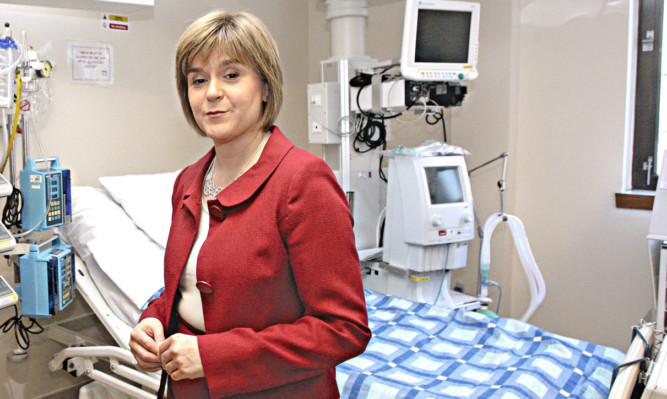
The number of NHS patients being treated in private hospitals has rocketed by more than 300% despite pledges to halt privatisation.
Startling new figures have revealed 6,417 patients were farmed out to private facilities last year, as hospitals struggle to hit stringent waiting time targets.
The staggering figure is more than FOUR times the 1,560 NHS patients treated privately just a decade ago.
A separate study recently revealed the NHS has spent nearly £100m sending its patients for private treatment over the past three years alone.
The revelations will come as an embarrassment to the SNP Government, which in 2011 claimed the private sector had been “eradicated” from Scotland’s NHS.
They are also likely to anger First Minister Nicola Sturgeon who has repeatedly promised to tackle the “creeping privatisation” of the health service.
Dr Jean Turner, former chief executive of the Scotland Patients Association, said: “It is down to decisions made in the 1990s when it was decided they would cut beds and more would be done in the community.
“No matter who is in Government at present nothing can be solved quickly because we have lost these beds.
“If you are going to admit somebody for an elective procedure you need to have a bed, maybe a high dependency bed or even an intensive care bed.
“There are then other things that need to be in place for a patient to go into hospital, and the truth is you end up having to lose your elective patients, because there are so many going through A&E that need to be admitted.”
NHS Lothian dispatched 2,199 people to private practices during 2013/14 which is more than any other in Scotland, and a staggering increase on the four patients treated privately in 2004/5.
NHS Grampian was second highest with 952 last year, compared to 645 a decade ago. Third was NHS Greater Glasgow and Clyde, which shipped out 901 patients last year compared to just 59 in 2004/5.
Jenny Marra, Scottish Labour’s shadow cabinet secretary for health, said: “As the pressure on our NHS intensifies, health boards are having to pay for patients to be treated privately to meet the SNP’s legally guaranteed waiting times.
“This is proving to be a massive cost to our health service and is allowing private health to profit from SNP policy.”
Meanwhile, separate data uncovered through a freedom of information request, found £94.2m has been shelled out to treat NHS patients in private hospitals and clinics over the past three years.
The sum would be enough to pay the wages of 1,400 newly qualified nurses for three years.
A quarter of the patients were treated in private facilities outside of their health board area including the south of England and the NHS has been forced to pick up the tab for transportation costs on numerous occasions.
However, it is understood a significant proportion of the overall bill is spent paying NHS doctors to give the treatment in their own time in private hospitals.
But Scottish Conservative health spokesman Jackson Carlaw welcomed the “valuable” contribution private providers are making. He said: “These figures show how valuable the independent health sector is in helping the NHS.
“They also expose the SNP’s horrific hypocrisy on the issue.
“Throughout the referendum it scaremongered about NHS privatisation, all the while increasing its own dependence on the sector.”
The revelations come just a month after the Scottish Government was forced to defend itself over the NHS’s failure to hit waiting times targets.
In December 89% of patients had to wait less than 18 weeks from being referred by their GP to being seen by a specialist, which was just short of the 90% minimum.
And in the last quarter of 2014, 2,000 patients waited more than 12 weeks from specialists agreeing a treatment was needed to it starting, despite a Government pledge all patients would have treatment within that time.
A Scottish Government spokesperson said: “The Scottish health service is seeing more patients than ever.
“It carried out a record of more than one million inpatient procedures last year, an increase of almost 18%, or 162,000, under this Government.
“Audit Scotland’s most recent assessment showed that NHS spending in the independent sector has actually fallen in the last year, and represents only 0.8% of the Scottish NHS frontline budget.”

Enjoy the convenience of having The Sunday Post delivered as a digital ePaper straight to your smartphone, tablet or computer.
Subscribe for only £5.49 a month and enjoy all the benefits of the printed paper as a digital replica.
Subscribe